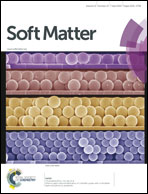Hybrid copolymer–phospholipid vesicles: phase separation resembling mixed phospholipid lamellae, but with mechanical stability and control
Abstract
Vesicles whose bilayer membranes contain phospholipids mixed with co-polymers or surfactants comprise new hybrid materials having potential applications in drug delivery, sensors, and biomaterials. Here we describe a model polymer–phospholipid hybrid membrane system exhibiting strong similarities to binary phospholipid mixtures, but with more robust membrane mechanics. A lamella-forming graft copolymer, PDMS-co-PEO (polydimethylsiloxane-co-polyethylene oxide) was blended with a high melting temperature phospholipid, DPPC (1,2-dipalmitoyl-sn-glycero-3-phosphocholine), over a broad compositional range. The resulting giant hybrid unilamellar vesicles were compared qualitatively and quantitatively to analogous mixed phospholipid membranes in which a low melting temperature phospholipid, DOPC (1,2-dioleoyl-sn-glycero-3-phosphocholine), was blended with DPPC. The mechanical properties of the hybrid vesicles, even when phase separated, were robust with high lysis stresses and strains approaching those of the pure copolymer vesicles. The temperature-composition phase diagram of the hybrid vesicles closely resembled that of the mixed phospholipids; with only slightly greater nonidealities in the hybrid compared with DOPC/DPPC mixed membranes. In both systems, it was demonstrated that tension could be used to manipulate DPPC solidification into domains of patchy or striped morphologies that exhibited different tracer incorporation. The patch and stripe-shaped domains are thought to be different solid DPPC polymorphys: ripple and tilt (or gel). This work demonstrates that in mixed-phospholipid bilayers where a high-melting phospholipid solidifies on cooling, the lower-melting phospholipid may be substituted by an appropriate copolymer to improve mechanical properties while retaining the underlying membrane physics.


 Please wait while we load your content...
Please wait while we load your content...